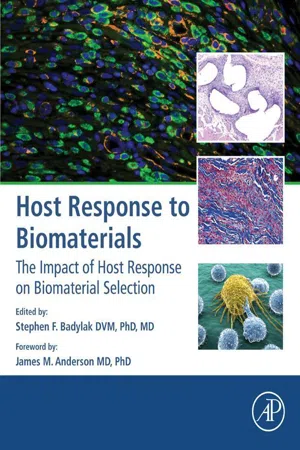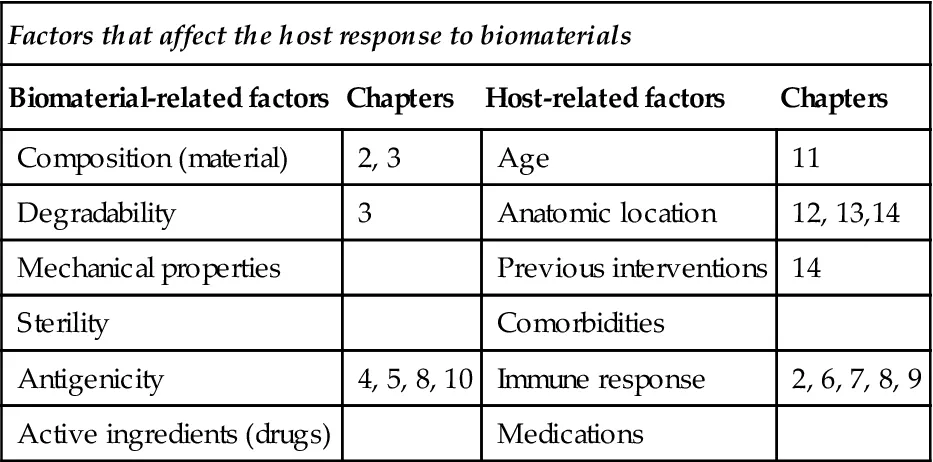
eBook - ePub
Host Response to Biomaterials
The Impact of Host Response on Biomaterial Selection
- 460 pages
- English
- ePUB (mobile friendly)
- Available on iOS & Android
eBook - ePub
Host Response to Biomaterials
The Impact of Host Response on Biomaterial Selection
About this book
Host Response to Biomaterials: The Impact of Host Response on Biomaterial Selection explains the various categories of biomaterials and their significance for clinical applications, focusing on the host response to each biomaterial. It is one of the first books to connect immunology and biomaterials with regard to host response.
The text also explores the role of the immune system in host response, and covers the regulatory environment for biomaterials, along with the benefits of synthetic versus natural biomaterials, and the transition from simple to complex biomaterial solutions.
Fields covered include, but are not limited to, orthopaedic surgery, dentistry, general surgery, neurosurgery, urology, and regenerative medicine.
- Explains the various categories of biomaterials and their significance for clinical applications
- Contains a range of extensive coverage, including, but not limited to, orthopedic, surgery, dental, general surgery, neurosurgery, lower urinary tract, and regenerative medicine
- Includes regulations regarding combination devices
Frequently asked questions
Yes, you can cancel anytime from the Subscription tab in your account settings on the Perlego website. Your subscription will stay active until the end of your current billing period. Learn how to cancel your subscription.
No, books cannot be downloaded as external files, such as PDFs, for use outside of Perlego. However, you can download books within the Perlego app for offline reading on mobile or tablet. Learn more here.
Perlego offers two plans: Essential and Complete
- Essential is ideal for learners and professionals who enjoy exploring a wide range of subjects. Access the Essential Library with 800,000+ trusted titles and best-sellers across business, personal growth, and the humanities. Includes unlimited reading time and Standard Read Aloud voice.
- Complete: Perfect for advanced learners and researchers needing full, unrestricted access. Unlock 1.4M+ books across hundreds of subjects, including academic and specialized titles. The Complete Plan also includes advanced features like Premium Read Aloud and Research Assistant.
We are an online textbook subscription service, where you can get access to an entire online library for less than the price of a single book per month. With over 1 million books across 1000+ topics, we’ve got you covered! Learn more here.
Look out for the read-aloud symbol on your next book to see if you can listen to it. The read-aloud tool reads text aloud for you, highlighting the text as it is being read. You can pause it, speed it up and slow it down. Learn more here.
Yes! You can use the Perlego app on both iOS or Android devices to read anytime, anywhere — even offline. Perfect for commutes or when you’re on the go.
Please note we cannot support devices running on iOS 13 and Android 7 or earlier. Learn more about using the app.
Please note we cannot support devices running on iOS 13 and Android 7 or earlier. Learn more about using the app.
Yes, you can access Host Response to Biomaterials by Stephen F. Badylak,Stephen F Badylak in PDF and/or ePUB format, as well as other popular books in Medicine & Medical Technology & Supplies. We have over one million books available in our catalogue for you to explore.
Information
Chapter 1
Factors Which Affect the Host Response to Biomaterials
Ricardo Londono1,2 and Stephen F. Badylak1,3, 1McGowan Institute for Regenerative Medicine, University of Pittsburgh, Pittsburgh, PA, USA, 2School of Medicine, University of Pittsburgh, Pittsburgh, PA, USA, 3Department of Surgery, University of Pittsburgh, Pittsburgh, PA, USA
The ability of a biomaterial to perform its intended in vivo function is ultimately dependent upon both the structural and biophysical properties of the material and the host response to the given material. Biomaterial-related factors affecting performance include its composition, mechanical and material properties, surface topography and molecular landscape, ability to resist infection, and proper surgical placement, among others. Host-related factors include age, nutritional status, body mass index, comorbidities such as diabetes, previous interventions at the treatment site, and medications being taken by the patient. The host response begins immediately upon implantation and consists of both the response to the inevitable iatrogenic tissue injury during device placement and the response to the material itself. The implantation-induced component resolves quickly as part of the normal wound healing process. However, the response to the material itself will last for the length of time the material is present in the host. The host response is the primary determinant of clinical success in most applications. Hence, the safety and efficacy of these technologies will be well served by placing emphasis upon the understanding of the host response and the dynamic interaction between biomaterial- and host-related factors that affect clinical outcomes.
Keywords
Host response; biomaterials; host–biomaterial interaction; immune response to biomaterials; biocompatibility; biotolerance; biomaterial-mediated tissue repair
Introduction
The ability of a biomaterial to perform its intended in vivo function is dependent on many factors including its composition, mechanical and material properties, surface topography and molecular landscape, ability to resist infection, and proper surgical placement, among others. However, the ultimate determinant of success or failure is the host response to the biomaterial.
The host response begins immediately upon implantation and consists of both the response to the inevitable iatrogenic tissue injury during device placement and the response to the material itself. In most cases, the implantation-induced component resolves quickly as part of the normal wound healing process. However, the response to the material will last for the length of time the material is present in the host. Materials which elicit a persistent proinflammatory response are likely to be associated with abundant fibrous connective tissue deposition and the downstream consequences of the effector molecules secreted by recruited inflammatory cells. Materials which either rapidly degrade or reach a steady state of tolerance with adjacent host tissue (see Chapter 3) are typically associated with minimal scarring, a quiescent population of resident inflammatory cells, and tissue types appropriate for the anatomic location.
The host response to an implanted material includes factors that relate to the biomaterial itself and factors that relate to the host (Table 1.1). Biomaterial-related factors have been the focus of studies for many years. Such factors include the base composition of the material (e.g., polypropylene versus polytetrafluoroethylene versus extracellular matrix), surface texture, surface ligand landscape, degradability, and device design parameters such as pore and fiber size, among others. Host-related factors, on the other hand, have been underappreciated as a determinant of the response. These factors include age, nutritional status, body mass index, comorbidities such as diabetes, previous interventions at the treatment site, and medications being taken by the patient, among others. No biomaterial is inert and the interplay between material and host-related factors should be considered in the design and manufacture of all biomaterials.
Table 1.1
Host-related and biomaterial-related factors which affect the host response and chapters in which they are discussed
| Factors that affect the host response to biomaterials | |||
| Biomaterial-related factors | Chapters | Host-related factors | Chapters |
| Composition (material) | 2, 3 | Age | 11 |
| Degradability | 3 | Anatomic location | 12, 13,14 |
| Mechanical properties | Previous interventions | 14 | |
| Sterility | Comorbidities | ||
| Antigenicity | 4, 5, 8, 10 | Immune response | 2, 6, 7, 8, 9 |
| Active ingredients (drugs) | Medications | ||
Biomaterial–Host Interaction
Although the physical and mechanical properties of a material at the time of implantation are important for obvious reasons, these properties are equally important at 1 month, 1 year, 5 years, and beyond, especially for those materials intended to remain in situ for the life span of the patient. The host response can degrade, destroy, encapsulate, or otherwise alter the composition of the biomaterial over time resulting in changes to the form and mechanical properties of the material itself (Figure 1.1) (Badylak, 2014). Hence, it is not the degree to which the physical characteristics of the material resemble the targeted anatomic location before implantation that determines the performance of a biomaterial, but rather the host response over time.

The host response to implanted biomaterials depends upon many factors. Although the initial stages of the biomaterial–host interaction are shared among all materials and include tissue damage during implantation and protein adsorption to the surface of the material, the host response quickly transitions into complex phases that depend directly upon the type of material being implanted and other factors. These phases involve cellular and molecular components of the innate immune system and the wound healing response, and will ultimately determine the clinical outcome (i.e., encapsulation vs. scar formation vs. constructive remodeling).
The host response is initiated with the activation of the innate immune system as a result of cell and tissue damage during biomaterial implantation (see Chapters 2, 3, 4). Upon contact with the host tissues, the surface of the biomaterial is coated with blood and plasma proteins through a process known as the Vroman effect (Slack et al., 1987). Depending on the type of biomaterial and surface topography (i.e., type I collagen vs. polytetrafluoroethylene vs. titanium), the type and amount of adsorbed molecules will vary, and consequently, so will the composition and arrangement of the interface molecules that exist between the host tissues and the implant.
As a result of the Vroman ef...
Table of contents
- Cover image
- Title page
- Table of Contents
- Copyright
- List of Contributors
- Foreword
- Preface
- Acknowledgments
- Chapter 1. Factors Which Affect the Host Response to Biomaterials
- Chapter 2. Perspectives on the Inflammatory, Healing, and Foreign Body Responses to Biomaterials and Medical Devices
- Chapter 3. The Biocompatibility of Implant Materials
- Chapter 4. Host Response to Naturally Derived Biomaterials
- Chapter 5. Molecular Events at Tissue–Biomaterial Interface
- Chapter 6. Macrophage Plasticity and Polarization: Relevance to Biomaterials
- Chapter 7. Role of Dendritic Cells in Response to Biomaterials
- Chapter 8. The Acquired Immune System Response to Biomaterials, Including Both Naturally Occurring and Synthetic Biomaterials
- Chapter 9. Fibrotic Response to Biomaterials and all Associated Sequence of Fibrosis
- Chapter 10. Human Anti-Gal and Anti-Non-Gal Immune Response to Porcine Tissue Implants
- Chapter 11. Aging and the Host Response to Implanted Biomaterials
- Chapter 12. Host Response to Orthopedic Implants (Metals and Plastics)
- Chapter 13. Host Response to Biomaterials for Pelvic Floor Reconstruction
- Chapter 14. Methods Used to Evaluate the Host Responses to Medical Implants In Vivo
- Index
